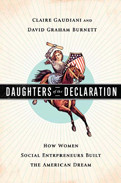
Daughters of the Declaration: How Women Social Entrepreneurs Built the American Dream
Claire Gaudiani & David Graham Burnett
355 pages, PublicAffairs, 2011
In the early days of the social entrepreneurship movement, you would know which kind of conference you were attending from its cast and costumes. Nonprofit conferences mostly featured women in interesting scarves and sensible footwear. Social entrepreneurship conferences mostly hosted men in sharp suits and conservative haircuts. An alien visiting our fair planet would quickly conclude that nonprofits were for women and social entrepreneurship was for men.
But that alien would be wrong, suggests a new book by spouses Claire Gaudiani and David Graham Burnett. In Daughters of the Declaration: How Women Social Entrepreneurs Built the American Dream, these authors argue that American women actually invented social entrepreneurship. The women’s inspiration, moreover, was not just softheartedness or maternal instinct; it was the Declaration of Independence and its rigorous philosophical underpinnings. And their results were nothing less than a nation that balances self-interest with collective well-being, ambition with virtue, and independence with interdependence.
In their attempt to prove both that 1) social entrepreneurship is the realization of America’s founding principles, and 2) women have been the primary stewards of that realization, the authors succeed in bringing to light many inspiring historical figures whom time threatens to obscure—a valuable contribution. Yet they fall short of capturing the motivations of these remarkable women.
To make the case that women were social entrepreneurs when social entrepreneurship wasn’t cool, Gaudiani and Burnett profile dozens of female abolitionists, suffragists, educators, researchers, philanthropists, and other reformers across centuries, ethnicities, classes, and avocations. The arrows in their quiver range from the unjustly obscure to the almost famous.
For instance, the authors relate how in the 18th century Katy Ferguson, a freed slave, established one of the nation’s first systems for educating poor black and white children. From the 19th century, they profile Elizabeth Seton, a well-heeled white woman, who established the first American religious order, the Sisters of Charity, and Mary Elizabeth Lange, a black refugee from the Caribbean, who created the first black religious order in the world, the Oblate Sisters of Providence. And from the 20th century, they retell how Florence Kelley, the daughter of an abolitionist, helped create the National Consumers League and how Mary McLeod Bethune, the daughter of slaves, founded Bethune-Cookman College and advised President Franklin D. Roosevelt as part of his Black Cabinet.
Gaudiani and Burnett pepper these profiles with tasty historical tidbits and clarifying context, which make for a fast and enjoyable read. They share the lament of Mary Livermore, suffragist and editor of the Woman’s Journal: “Is it not pitiful that we rear young girls as if they were human lobsters which, when stranded on the rocks or the shore, must wait for some friendly wave to float them again?” They quote Bethune: “What then does the Negro want? He wants opportunity to make real what the Declaration of Independence and the Constitution and Bill of Rights say.”
Unlike Bethune, however, most of Gaudiani and Burnett’s protagonists do not explicitly cite founding documents as their modus operandi, nor do they speak the business lingo of social entrepreneurship. This does not prevent the authors, however, from conjecturing that they did. “In her deep and careful conservatism,” they write of philanthropist Caroline Phelps Stokes, “she believed that the argument of the Declaration of Independence would prove correct when opportunities for all were equalized.” Perhaps. But the authors offer no quotes or sources to support this inference. And although the authors acknowledge, “Perhaps neither Katy Ferguson nor Grace Dodge [an education reformer and founding funder of Teachers College at Columbia University] would approve of our defining their work as human capital development,” they nevertheless conclude, “No matter.”
Yet it does matter. These women spent their lives resisting other people’s attempts to put words in their mouths and thoughts in their heads. In addition, this application of business metaphors obscures the possibility that these women intervened precisely because they had not adopted the prevailing business wisdom of their day. As mothers, teachers, nurses, and women of the cloth, they sat outside dominant economic and political institutions. From this outsiders’ perch, they could see the damage that laissez-faire capitalism, slavery, disenfranchisement, unregulated labor practices, and other early blights wrought on their communities. And it is from this position that they acted.
By cloaking these women’s pro-social actions in business sector trappings, the authors mask that many of these women were acting not only out of enlightened self-interest or other tenets of the Declaration of Independence, but also out of empathy, compassion, and interdependence.
In the meantime, perhaps Gaudiani and Burnett’s treatment of these female revolutionaries as “social entrepreneurs” will attract a new and broader fan base. If this was their intention, they learned their heroines’ lessons well: to speak your truth to mainstream audiences, you have to use their language. As is always the case in translation, however, original intentions often get lost.

